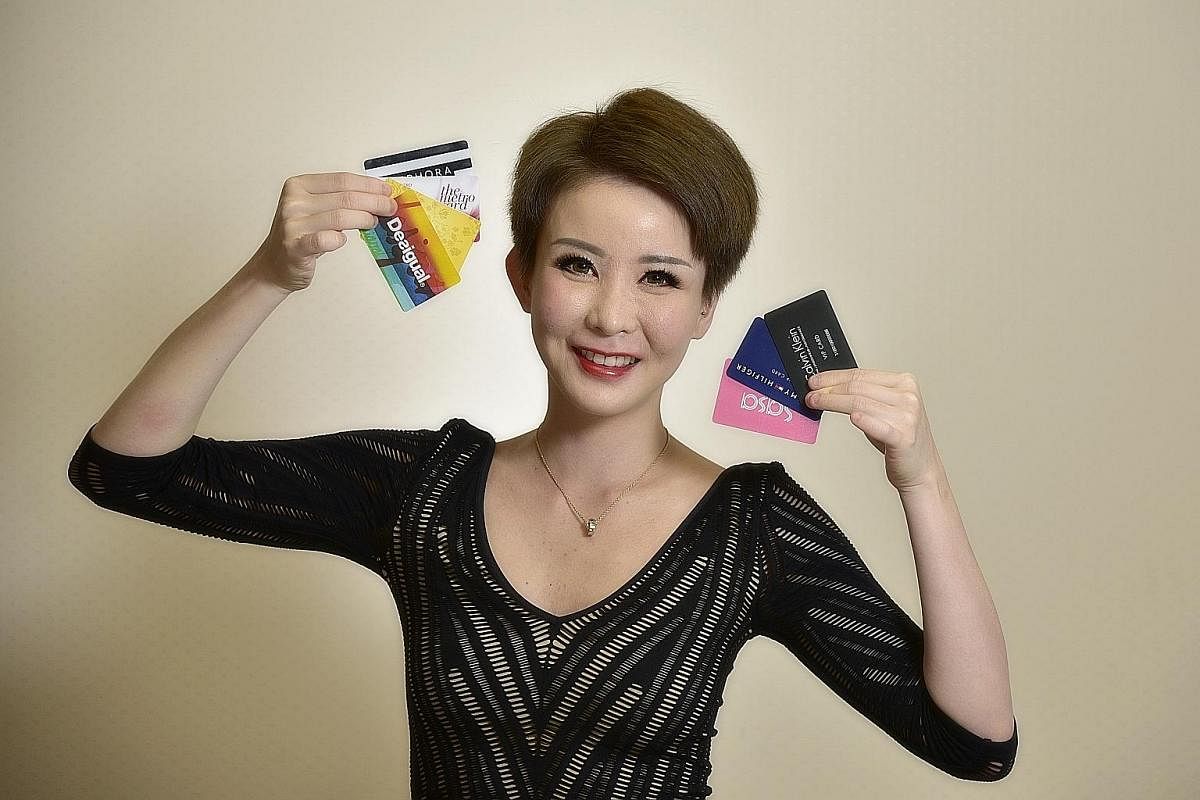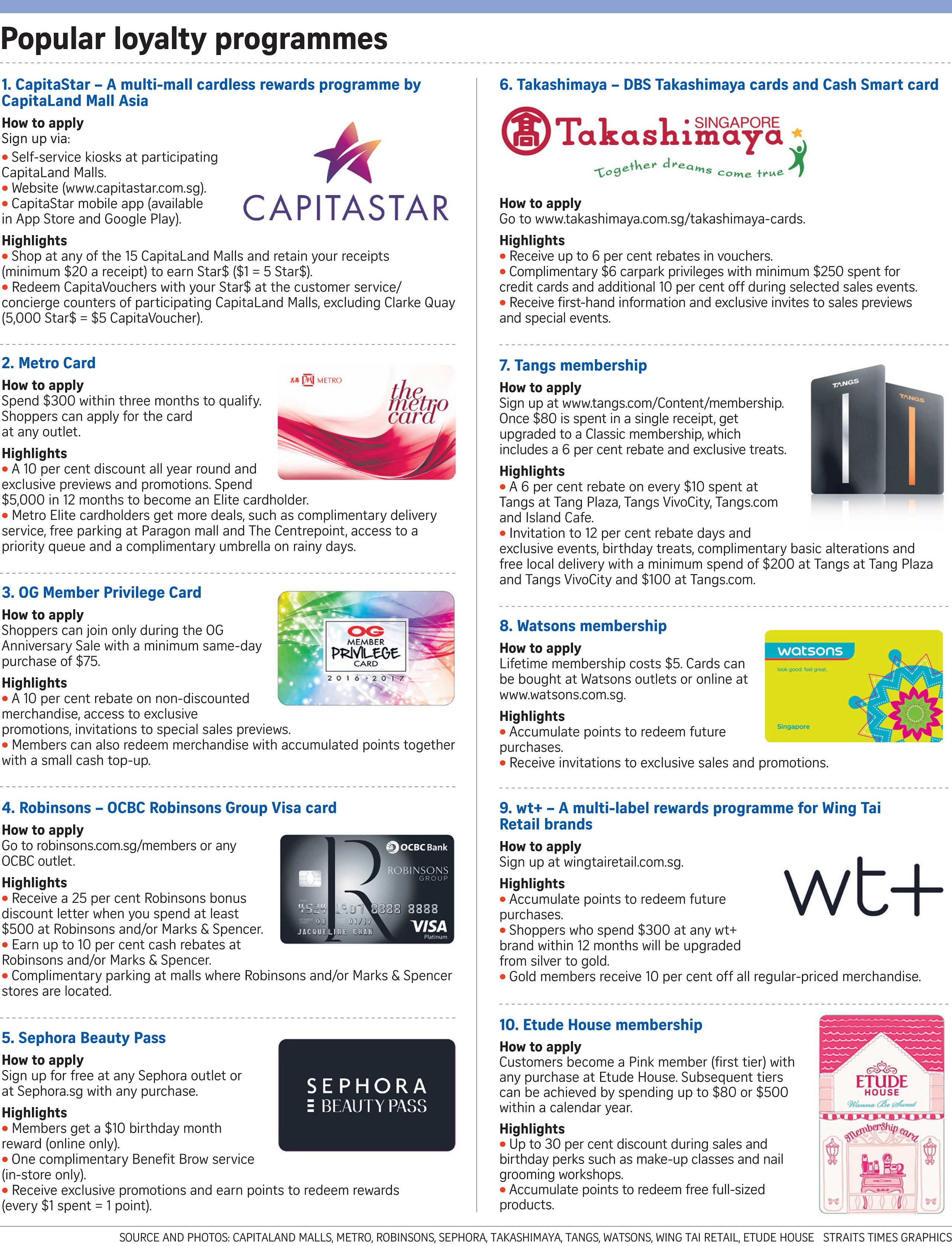Brick-and-mortar stores hedging on loyalty programmes to keep customers keen
More department stores, malls and brands are launching or ramping up loyalty programme benefits to retain shoppers


In the cut-throat retail environment, brick-and-mortar stores - suffering from low shopper traffic, decreased spending and competition from e-commerce - are hedging on loyalty programmes to keep their customers keen.
Though the concept of a loyalty programme is not new, a check with department stores and bigger retail chains here found that businesses are ramping up their membership benefits to retain shoppers.
A Straits Times check with 13 retailers found that half updated their programmes last year.
Department store Robinsons, which has a membership card tie- up with local bank OCBC, will soon launch a loyalty programme for shoppers who do not wish to own a credit card, yet want to enjoy privileges. Members of The R List can get free consultations with personal shoppers and updates on the latest launches and events.
Those with the OCBC Robinsons Group card can also get rebates not only at Robinsons, but also at 18 brands such as Lacoste and Ted Baker - a change made in 2015.
Over at CapitaLand Mall Asia, which manages 15 malls in Singapore, CapitaStar members now have Sparkle at their disposal - an artificial intelligence chatbot launched in November. Through a mobile app, shoppers can ask Sparkle to hail a cab, book a restaurant online or give store recommendations.
Those with the American Express CapitaCard, launched in July, get free parking for three hours (a mall a day) at participating malls with a minimum spending of $1,200 a month on the card. This is in addition to Star$, which can be accumulated and exchanged for vouchers.
CapitaStar's membership, says Ms Teresa Teow, CapitaLand Mall Asia's Singapore head of retail management, has more than doubled in Singapore in the past three years to more than 770,000 members. The programme, she says, helps the group to "extend and deepen our customer engagement".
Beauty labels are also upping the ante.
South Korean label Laneige, which used to give members only occasional discounts and allow them to accumulate points to redeem products, started inviting VIP members to exclusive events and a year-end party. Such members, who have to spend at least $800 a year, also get an $80 shopping voucher.
A Laneige spokesman declined to disclose how many members it has, but says the figure has been growing each month.
Besides extra discounts at islandwide sales, cosmetics brand Etude House recently started giving members treats during their birthday month, including nail art classes for up to three people.
And since last month, members at South Korean label Sulwhasoo can redeem higher-tiered items using fewer points than before.
Orchard Road Business Association executive director Steven Goh says such programmes can "really help retain shoppers".
"People want better service and more discounts. The programmes mean that frequent shoppers are rewarded with these things, so they work to bring customers back," he says, adding that 70 per cent of the association's corporate members have loyalty programmes.
A survey conducted by research firm Nielsen of 353 shoppers here seems to bear this out. The poll shows that 67 per cent strongly or somewhat agreed that they shopped more frequently and spent more at stores with loyalty programmes.
The study, conducted last year, also found that 66 per cent of consumers would buy from a retailer with a loyalty programme over one without, with all other factors being equal.
Mr Raymond Cheung, Nielsen Singapore's head of retailer vertical, says a robust loyalty programme can help a retailer "reduce the customer's likelihood to switch stores".
Such programmes, says Associate Professor Li Xiuping of the National University of Singapore Business School's department of marketing, lend a sense of exclusivity to the shopping experience.
"Membership programmes add to consumers' social image through invitations to exclusive events and give them a sense of belonging through opportunities to connect with those who are similar to them," she says, adding that retailers can also use the information gathered from members to understand them better.
"They can carry out targeted promotions and offer customised services and products based on this information."
As for the way forward, Mr Samuel Tan, course manager of retail management at Temasek Polytechnic's School of Business, says brands can collaborate to come up with co-branded cards.
This, he says, benefits both retailers and shoppers. "Retailers can tap on one another's customer base, while shoppers can be offered more incentives."
More retailers are seeing the benefits of such programmes.
Local women's fashion label Klarra, which was launched in 2014, started its loyalty programme last year. Members can accumulate points to exchange for vouchers and get exclusive invites to sale events and launches, cut-price workshops, and a 20 per cent birthday discount.
Founder Beatrice Tan says the programme was launched to "show appreciation to returning customers" and adds that there has been a 25 to 30 per cent increase in membership since it started.
Local contemporary label In Good Company's version started about a year ago.
Tagged to spending - anyone who spends $2,000 within a year qualifies for the label's frequent shopper status - its programme gives members a $50 voucher for every $2,000 spent, exclusive previews to new collections, priority to attend events and occasional surprise treats such as movie tickets, cakes and coffee, flowers, notebooks and small leather goods.
Research analyst Clara Lam, 26, who has 12 loyalty cards, says she likes the programmes because they give her discounts and rebates.
"I shop quite a lot, so saving a dollar here and a dollar there adds up to a good amount."
Shopper Audrey Chen, 26, who says she saves about $1,500 a month from her loyalty programmes, says she loves them because of how they make her feel.
The entrepreneur in the beauty industry has at least 40 memberships at fast-fashion labels, beauty stores and luxury brands.
She says: "I appreciate the special treatment because it makes me feel like a princess. Besides the discounts, it is also about being included on a more prestigious level."
Saving more than $600 yearly through memberships
For avid shopper Macrina Lin, 23, loyalty programmes are all about getting "bang for your buck".
The beauty junkie, who is a relationship manager in the maritime industry, is a member of 10 such programmes - from department store Metro and South Korean cosmetics label Innisfree to personal care store Watsons and local shoe label Charles & Keith.
She says that these help her save $600 to $800 a year.
"I also love it when brands prepare something exclusive during my birthday month. It makes me feel more special and looked after," she says, adding that she uses her Sephora and Watsons cards most often. "I frequent Watsons because it sells my daily necessities, and with its dollar-to-point loyalty system, it is a better deal for my money, knowing that I save more in the long run."
Sephora members, she says, get exclusive promotions and invitations to members-only events throughout the year - including meet-and-greet sessions with cosmetic label founders and famous brand ambassadors. The bachelorette has also won cosmetic items from festive lucky draws for members.
She also attended an exclusive one-day sale at Metro Paragon a couple of years ago.
"The staff served drinks while we shopped," she says, adding that the number of customers allowed into the event was capped so it was not too crowded. "It was one of the more pleasant shopping experiences I have had as it felt great to walk into a store during after-work hours without so many people."
Bonuses like these, she says, draw her back.
"As I know I can get a discount or perhaps a free item, it's more comforting to shop and spend more. Psychologically, it becomes more acceptable to buy," she adds.
So strong is the pull that Ms Lin says she would gladly walk an extra 15 minutes to a store at which she has a membership, instead of buying an identical item at a store that is closer to her.
She says: "It's not that far and saving is still saving. I would go the distance."
Join ST's Telegram channel and get the latest breaking news delivered to you.
A version of this article appeared in the print edition of The Straits Times on February 23, 2017, with the headline Brick-and-mortar stores hedging on loyalty programmes to keep customers keen. Subscribe


